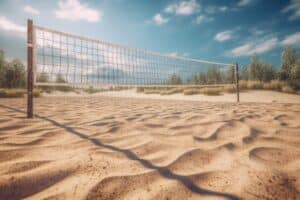How Deep is the Sand on a Sand Volleyball Court?
Key Takeaways
- The average depth of sand on a sand volleyball court is typically around 30 centimeters or 12 inches.
- The depth of sand on a sand volleyball court is crucial for stability, cushioning, and ball control.
- Proper maintenance is essential to keep the sand volleyball court in optimal condition, including regularly checking the sand depth and making adjustments if necessary.
When it comes to sand volleyball courts, one of the most important aspects is the depth of the sand. The depth can greatly impact the playability and safety of the court. So, how deep is the sand on a sand volleyball court?
The average depth of sand on a sand volleyball court is typically around 30 centimeters or 12 inches. This depth provides a good balance between stability and cushioning for players. It allows for proper foot planting and jumping while also reducing the risk of injuries from falls.
The Importance of Sand Depth
The depth of sand on a sand volleyball court is crucial for several reasons. Firstly, it affects the stability and firmness of the court. The right amount of sand ensures that players can move quickly and make sharp turns without sinking too much. It also helps to prevent injuries caused by uneven surfaces or tripping over loose sand.
Secondly, the depth of sand impacts the cushioning and shock absorption properties of the court. Sand acts as a natural shock absorber, reducing the impact on players’ joints when they land after a jump. The right depth of sand provides enough cushioning to protect players from injuries such as sprained ankles or knee strains.
Lastly, the depth of sand can also affect the ball’s behavior during a game. Sand courts are designed to slow down the ball’s speed and make it more challenging to control. The depth of sand plays a role in this, as it affects the ball’s bounce and how it interacts with the sand surface.
Recommended Depth of Sand
Various sources recommend a depth of around 30 centimeters or 12 inches for the sand on a sand volleyball court. This measurement ensures that the court meets the standard depth for a beach volleyball court. It provides the ideal balance between stability, cushioning, and ball control.
Measuring the sand depth on a sand volleyball court is relatively straightforward. One method is to rake the sand level and measure from the surface of the sand to the ground. This will give an accurate measurement of the sand depth.
Maintenance and Safety
Proper maintenance is essential to keep the sand volleyball court in optimal condition. Regularly raking the sand helps to keep it even and prevent any depressions or mounds from forming. It is also important to remove any debris, such as rocks or shells, that may pose a safety hazard to players.
In addition to maintaining the sand, it is recommended to periodically check the sand depth and make adjustments if necessary. Over time, the sand may become compacted or displaced, requiring additional sand to be added to maintain the proper depth.
Conclusion
The depth of sand on a sand volleyball court is typically around 30 centimeters or 12 inches. This depth provides the right balance of stability, cushioning, and ball control for players. It is important to regularly maintain the sand and check its depth to ensure optimal playing conditions and safety.
Related Websites:
FAQs:
Q: Why is sand depth important in a sand volleyball court?
The sand depth in a sand volleyball court is important for player safety and performance. Adequate sand depth helps absorb impact, reducing the risk of injuries, and provides a suitable playing surface for optimal gameplay.
Q: What factors influence the ideal sand depth for a sand volleyball court?
The ideal sand depth for a sand volleyball court is influenced by factors such as the level of play, player preferences, and the type of sand used. Other factors may include climate, location, and governing body regulations.
Q: How is the recommended sand depth determined for a sand volleyball court?
The recommended sand depth for a sand volleyball court is determined by general guidelines and standards set by governing bodies. Additionally, regional and environmental factors, such as weather conditions and local preferences, are taken into consideration.
Q: What methods are used to maintain and adjust sand depth on a sand volleyball court?
Weather conditions can impact sand depth, and regular maintenance is required. Methods for maintaining and adjusting sand depth include raking, leveling, and adding more sand when necessary to ensure a consistent playing surface.
Q: How can I accurately measure the sand depth on a sand volleyball court?
To measure the sand depth on a sand volleyball court, you can use tools such as a measuring tape or a depth gauge. Follow step-by-step instructions provided by professionals to ensure accurate measurement and maintain the recommended sand depth for optimal gameplay.






